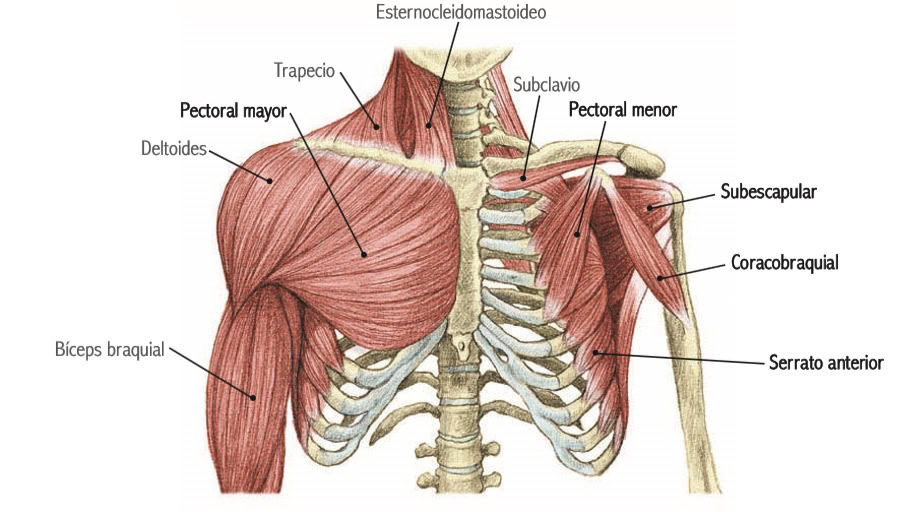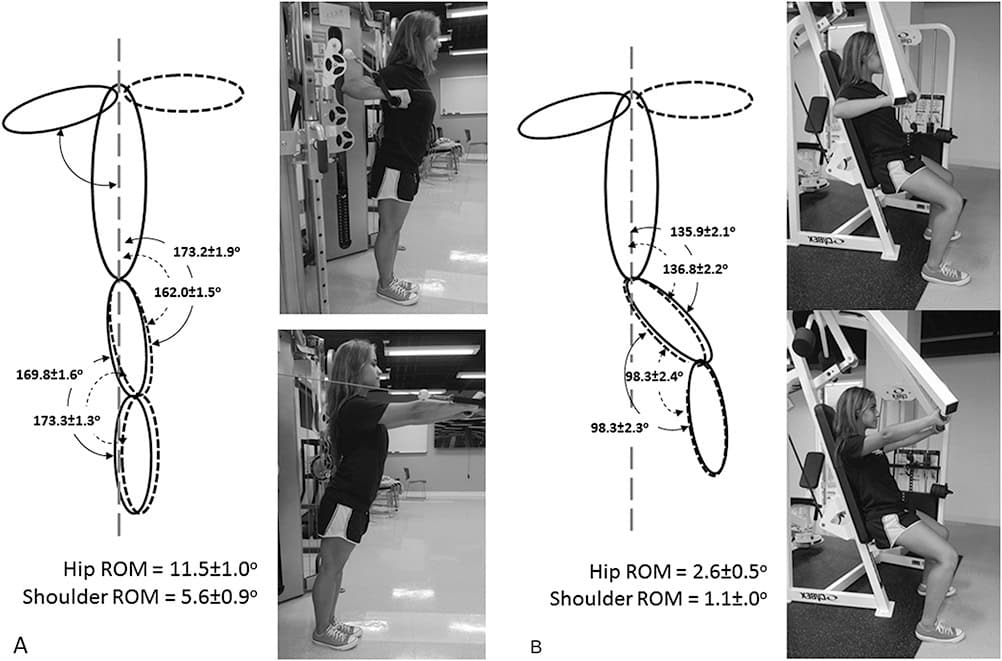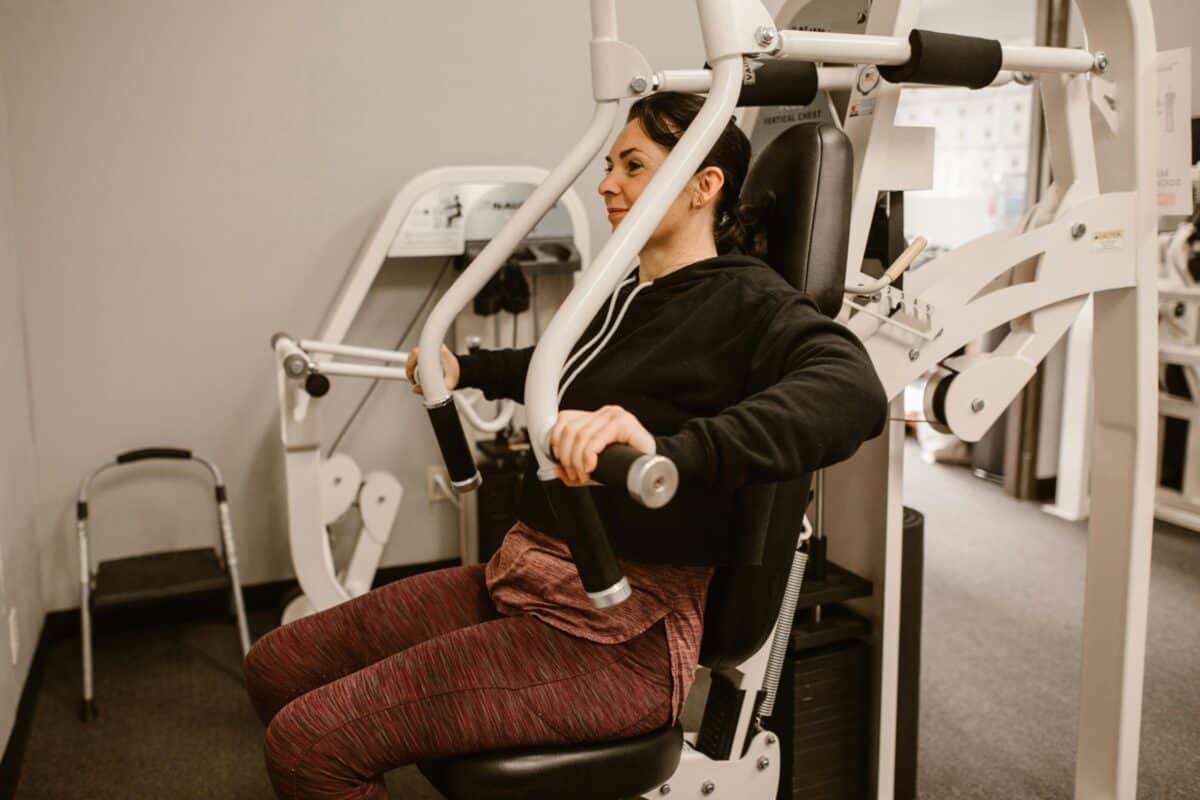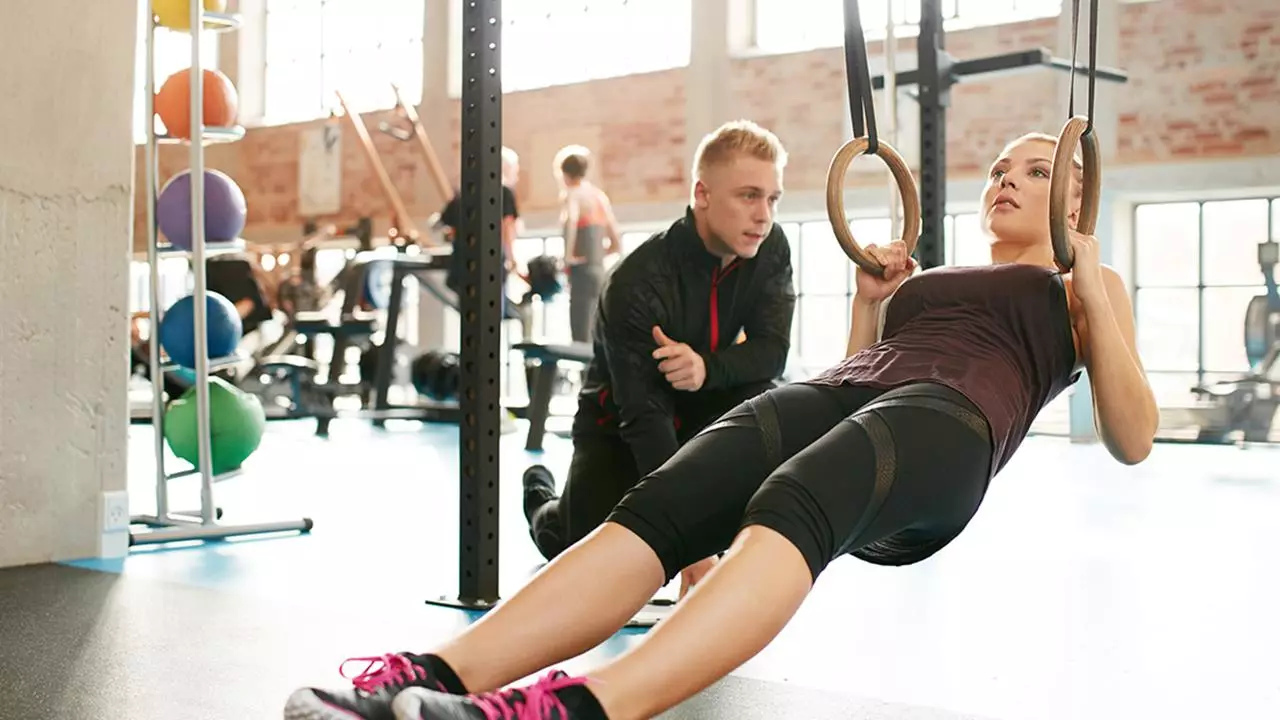In the selection of exercises, different variables can be manipulated, one of them is the use of different types of chest gym machines exercises, this article deals with this topic.
What are the chest gym machine exercises?
The selection of exercises is one of the variables in which for trainers it becomes a critical situation since in this aspect there are different types of chest gym machine exercises when programming strength training, and in it coexist the posture of the body, the number of muscles used, selecting single-joint exercises or multi-joint exercises, the types of grip, position of the hands and feet, the range of motion or the use of equipment (1).
At this point, chest gym machine exercises can be influenced by the type of equipment used, whether with free weights, machines, pulleys, or elastic bands.
For this, in the use of machines, the stability variables are different in relation to the use of free weight, and the range of motion is different between the use of machines and pulleys, since in chest gym machine exercises guided unidirectional movements are used, which influences the production of force when performing this type of exercise (2).
Pectoral myology: a brief review of the chest muscles
With the aim of stimulating the chest muscles, chest gym machine exercises offer the possibility of stimulating not only the portions of the pectoral but also the anterior deltoid and the triceps, with which in this section the main characteristics of the muscle groups for this purpose are named.
[article ids=”92251″] The pectoralis major muscle (anterior, superficial), originates in the clavicle, ribs, and sternal membrane, whose insertion is in the humerus, and the main functions it performs are arm anteversion if it is in abduction, adduction, and medial rotation and is accessory in breathing.
The subscapular muscle (anterior, deep), originates in the scapula and inserts in the humerus, performing the function of internal rotation of the arm. On the side of the anterior deltoid, it is mainly responsible for shoulder elevation, especially in horizontal flexion and internal rotation (4).
Another muscle involved in chest gym machine exercises is the triceps, with which it originates in the scapula, humerus, and inserts in the ulna and posterior surface of the capsule. The main function is elbow extension, retroversion, and adduction (4).
In the table below, a brief summary of the muscles involved in the chest gym machine exercises proposed by Vella, M. (2007) is shown.
|
Muscle group |
Involved joints |
Origin |
Insertion |
Actions |
|---|---|---|---|---|
| Pectoralis major | Shoulder | In the clavicle, sternal portion, and surfaces of the rib cartilages | Humerus | In the shoulder, adduction, horizontal adduction, internal rotation, and flexion |
| Pectoralis minor | Scapulas to ribs | Anterior surface of the 3rd to 5th rib | Scapula | In the scapula, abduction (protraction), downward rotation, and descent |
| Anterior deltoid | Shoulders | Clavicle | Humerus | In the shoulder, flexion, horizontal flexion, and medial rotation |
| Triceps brachii | Shoulders and elbows | Scapula and humerus | Olecranon of the ulna | Elbow extension |
| Serratus anterior | Shoulders | 9th rib on the chest side | Scapula | Scapula, protraction, and upward rotation |
| Coracobrachialis | Shoulders | Coracoid process of the shoulder | Diaphysis of the humerus | Horizontal adduction of the shoulder |
| Anconeus | Elbows | Condyle of the humerus | Olecranon of the ulna | Elbow extension |
As mentioned, these muscle groups act in the different variants of chest gym machine exercises, and in the following section, we will discuss them.
Variants of chest gym machine exercises
In order to provide readers with variants of the use of chest gym machine exercises, in this section we bring the most common exercises used in the training room, such as the Smith machine, seated machine, or use of pulleys, which for fitness trainers could be very useful since there are many difficulties when selecting exercises appropriate to the objectives of each trainee.

In the image presented, the musculature involved in chest gym machine exercises is observed.
Bench press on Smith machine
This type of chest gym machine exercise is characterized by being performed lying on a bench, taking the bar of the guided machine, with the back and head supported on the bench, executing controlled eccentric and concentric actions, bringing the bar towards the chest having contact with it.
On the other hand, the bench press on Smith machine or multipower is used in bodybuilding preparation, as it allows better recovery over 72 hours compared to a bench press with a bar or greater muscle congestion (1 and 6).
Common mistakes that appear in the execution of this exercise are the poor regulation of the machine’s height, the placement of the bench, too much bounce of the bar on the chest, incorrect elbow locking, uneven push, and poor load regulation.
Esquerdo, M. (2008).
That said, a variant of chest gym machine exercises is to perform it with an inclined bench at 30° or 45°, with the aim of working the clavicular area of the pectoral, it also allows the advantage of taking the weight from above, being guided by the machine, being able to leave the weight at any time of the series, and most importantly, it allows working with different degrees of inclinations (4).
Chest press on cable machine or pulley crossover
The equipment of pulley exercises has gained great interest in training, which allows combining training with free weights, machines, and pulleys. Such is the case that chest gym machine pulley exercises offer the possibility of training with greater ranges of motion, offering tension in the musculature at certain moments of the selected exercise, unlike the bar or dumbbells (4).
Common mistakes of this type of exercise are performing a press when wanting to do some type of opening but due to a technique defect not by intention to perform it, making excessive trunk swings, or loading weights difficult to complete the repetitions.
Esquerdo, M. (2008).
For the cable chest press, the subject will be asked to stand or sit, with the elbows aligned to the pulley grip, and execute a pushing action moving the cable away from the body, or trying to cross the pulleys, or perform it unilaterally (2 and 4).
On the other hand, a variant of chest gym machine exercises is to perform openings lying on a flat or inclined bench, with the caveat that in the last part of the movement (when the hands come together) the tension of the pulley remains high, unlike dumbbell openings that have tension in the first part of the movement and very little at the end. This pulley variant could present that advantage (4).
Seated or lying chest gym machine exercises
The seated chest press machine is an exercise that targets the work of the pectoralis major, anterior deltoid, and triceps brachii. For this, the performer will be required to sit on the machine with the back supported on the backrest, taking the machine’s grip, supporting the hip on the backrest, and the feet on the floor, and executing a pushing action of the machine moving the supports away from the body (2).
As advice, Esquerdo, M. (2008) mentions that special care should be taken when taking the weight in the first repetition, in case the machine presents difficulties in its function.

In other words, in the study conducted by Signorile, J. F. and collaborators (2017), they compared the activation of the triceps brachii between chest gym machine exercises and pulley and found as a result that the triceps brachii was exercised more with greater activity during training with disc machines compared to pulley training.
Another variant of chest gym machine exercises is to perform it on a machine lying flat or inclined, with which the pectorals, anterior deltoid, and triceps would be involved, the movement is the same as the previous one with the caveat that it is performed lying with a flat bench or an inclined bench to emphasize the clavicular area of the pectoral (4).
Common mistakes that appear in the use of machines are poor regulation of posture in the machine, excessive work of the triceps, elbow locking too high, and uneven push with both arms.
Esquerdo, M. (2008).
On the other hand, this exercise can provide the advantage of starting to use it with beginner people since the machine helps guide the movement, making it easier to learn than the bench press or to master like the dumbbell press (4).
Advantages and benefits of performing chest gym machine exercises
As mentioned in the executions of chest gym machine exercises, the main advantages offered by their use are:
For beginners, it would allow starting to learn with guided chest gym machine exercises, taking into account the care of the machine’s use (4 and 6).
In experienced people in training, it offers the possibility of exerting a kind of “pectoral muscle congestion” and the muscles involved in chest gym machine exercises (6).
The machine having different types of grip, offers the possibility of exerting force in different grips (2 and 3).
In people with little strength, it would allow offering a more focused work on gaining strength and muscle mass, removing the “muscle stabilizers,” contrary to what happens in a bench press or with dumbbells (3).
For people who suffer from joint difficulties, chest gym machine exercises could offer great advantages (3).
In the field of rehabilitation, chest gym machine exercises offer the possibility of recovering movement with little load, proposing a type of functional training (3).
The variety of chest gym machine exercises offers significant improvements at the muscular level by combining machine training with free weight in people who train recreationally (7).
Improves muscle strength and development, both in untrained men and in people with training experience (8).
Conclusions of chest gym machine exercises
With the aim of varying the levels of muscle stimulation, the choice of different chest gym machine exercises becomes a great tool, which can be viable with the aim of improving and increasing the repertoire of exercises for trainers, therapists, or sports physical trainers, whose main objective will aim at the specificity of the required activity.
In other words, the use of free weights will require greater joint stability while the use of machines would allow reducing stability processes, as they would be provided by the machine itself (3).
Meanwhile, there is evidence that supports that both the use of chest gym machine exercises and free weights would improve musculoskeletal functionality, serve in the field of rehabilitation, or as a learning mode in people who are just starting training (7).
For this reason, one of the difficulties for fitness trainers is the possibility of selecting exercises and material that are appropriate to meet the objective of the trainees.
Bibliographic references
-
Ferreira, D. V., Ferreira-Júnior, J. B., Soares, S. R., Cadore, E. L., Izquierdo, M., Brown, L. E., & Bottaro, M. (2017). Chest Press Exercises With Different Stability Requirements Result in Similar Muscle Damage Recovery in Resistance-Trained Men. Journal of strength and conditioning research, 31(1), 71–79. https://doi.org/10.1519/JSC.0000000000001453.
-
Signorile, J. F., Rendos, N. K., Heredia Vargas, H. H., Alipio, T. C., Regis, R. C., Eltoukhy, M. M., Nargund, R. S., & Romero, M. A. (2017). Differences in Muscle Activation and Kinematics Between Cable-Based and Selectorized Weight Training. Journal of strength and conditioning research, 31(2), 313–322. https://doi.org/10.1519/JSC.0000000000001493.
-
Schott, N., Johnen, B., & Holfelder, B. (2019). Effects of free weights and machine training on muscular strength in high-functioning older adults. Experimental gerontology, 122, 15–24. https://doi.org/10.1016/j.exger.2019.03.012.
- Esquerdo, M. (2008). Encyclopedia of muscle building exercises. Editorial, Edu Futness. Madrid, Spain.
- Vella, M. (2007). Anatomy and muscle building for strength and fitness training. Editorial Paidotribo. Bandalona, Spain.
- Delavier, F. (2011). Guide to muscle building movements. Anatomical description. Editorial Paidotribo. Spain.
-
Aerenhouts, D., & D’Hondt, E. (2020). Using Machines or Free Weights for Resistance Training in Novice Males? A Randomized Parallel Trial. International journal of environmental research and public health, 17(21), 7848. https://doi.org/10.3390/ijerph17217848.
-
Yoo, J., Kim, J., Hwang, B., Shim, G., & Kim, J. (2022). Estimation of 1-Repetition Maximum Using a Hydraulic Bench Press Machine Based on User’s Lifting Speed and Load Weight. Sensors (Basel, Switzerland), 22(2), 698. https://doi.org/10.3390/s22020698.


